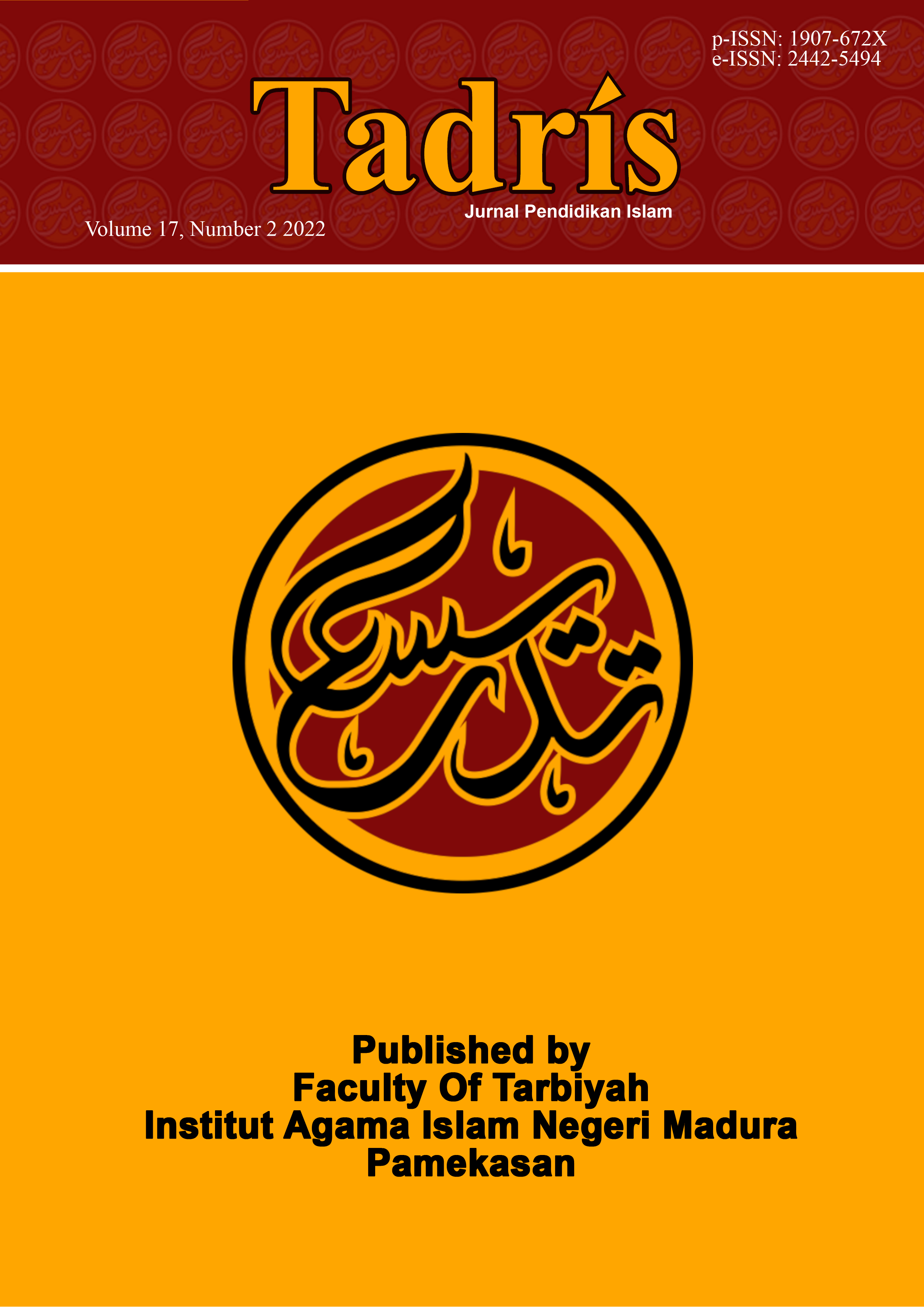Digital Parenting: Utilizing Technology to Instill Islamic Education Values in Young Children
 Abstract views: 1089
,
Abstract views: 1089
,
 PDF downloads: 522
PDF downloads: 522
Abstract
Early use of technology always has advantages and disadvantages in social interactions. Some neighborhood organizations believe that technology may promote accountability, pragmatism, security, and convenience. Other groups, meanwhile, believe that gadgets are prone to criminality. Gadgets must be present since they are an unavoidable aspect of life. Use intended for young children requires parental supervision. Similarly, technology can be employed as a teaching tool. The study's goal was to investigate how Islamic education ideals are taught to young children through the use of technology. This study used descriptive qualitative research as its methodology. ways for gathering data through observation, interviews, and documentation. Ten parents of young children participated as informants in the study. Data reduction and exposure stages, as well as inference and data verification, are all used in technical analysis of the data. By using three different procedures and data sources, the veracity of the data is tested. The study's findings demonstrate that: First, early childhood care can be provided using either an authoritative parenting style, which limits children's independence while granting them authority, or a permissive parenting style, which pampers them. Second, using technology as media is one way that parents today are instilling Islamic education values which includes aspects of aqidah, worship (ibadah), and morals (akhlak) in their children. Third, gadgets have a negative impact on early childhood including cyberbullying, pornography, blasphemy and speaking impolitely in cyberspace, then children think instantly, are less active, addicted to gadgets and result in a consumptive lifestyle.
Downloads
References
Antar, Rafi. “Exploring the Use of Electronic Media in Young Children’s Lives and Its Effects on Brain Development.” Varhaiskasvatuksen Tiedelehti Journal of Early Childhood Education Research 8, no. 1 (2019): 59–73. http://jecer.org.
Baharun, Hasan, and Febri Deflia Finori. “Smart Techno Parenting: Alternatif Pendidikan Anak Pada Era Teknologi Digital.” Jurnal Tatsqif 17, no. 1 (2019): 52–69. https://doi.org/10.20414/jtq.v17i1.625.
Bandura, Albert. “Social Cognitive Theory.” Annalis of Child Development 6, no. 1 (1989): 1–60.
Baumrind, Diana. “Commentary on Sexual Orientation: Research and Social Policy Implications.” Developmental Psychology 31, no. 1 (1995): 130–36.
———. “Current Patterns of Parental Authority.” Developmental Psychology Monographs 4 (1971): 1–101.
———. “Patterns of Parental Authority and Adolescent Autonomy.” New Dir Child Adolesc Dev 108 (2005).
Bronfenbrenner, Urie. “Ecological Models of Human Development.” International Encyclopedia of Education 3, no. 2 (1994): 37–43.
Fatmawati, Nur Ika. “Literasi Digital, Mendidik Anak Di Era Digital Bagi Orang Tua Milenial.” Jurnal Politik Dan Sosial Kemasyarakatan 11, no. 2 (2019): 119–38.
Hameed, Shafqat, Atta Badii, and Andrea J Cullen. “Effective E-Learning Integration with Traditional Learning in a Blended Learning Environment.” In European and Mediterranean Conference on Information Systems 2008 (EMCIS2008), 2008.
Hidasari, Fitriana Puspa. “Intensitas Penggunaan Gadget Dan Aktivitas Motorik Anak Usia 4-6 Tahun.” Jurnal Altius: Jurnal Ilmu Olahraga Dan Kesehatan 8, no. 2 (2019): 85–91.
Hijriyani, Yuli Salis, and Ria Astuti. “Penggunaan Gadget Oleh Anak Usia Dini Pada Era Revolusi Industri 4.0.” ThufuLA: Jurnal Inovasi Pendidikan Guru Raudhatul Athfal 8, no. 1 (2017): 15–28.
Huda, Khairul, and Erni Munastiwi. “Strategi Orang Tua Dalam Mengembangkan Bakat Dan Kreativitas Di Era Pandemi Covid-19.” Jurnal Pendidikan Glasser 4, no. 2 (2020): 80–87.
Kirschner, Paul A., and Pedro De Bruyckere. “The Myths of the Digital Native and the Multitasker.” Teaching and Teacher Education 67 (2017): 135–42. https://doi.org/10.1016/j.tate.2017.06.001.
Konok, Veronika, Nóra Bunford, and Ádám Miklósi. “Associations between Child Mobile Use and Digital Parenting Style in Hungarian Families.” Journal of Children and Media 14, no. 1 (2020): 91–109. https://doi.org/10.1080/17482798.2019.1684332.
Kyriazos, Theodoros A., and Anastassios Stalikas. “Positive Parenting or Positive Psychology Parenting? Towards a Conceptual Framework of Positive Psychology Parenting.” Psychology 09, no. 07 (2018): 1761–88. https://doi.org/10.4236/psych.2018.97104.
Lauricella, Alexis R., Ellen Wartella, and Victoria J. Rideout. “Young Children’s Screen Time: The Complex Role of Parent and Child Factors.” Journal of Applied Developmental Psychology 36, no. 11–17 (2015). https://doi.org/https://doi.org/10.1016/j.appdev.2014.12.001.
Maccoby, E. E., & Martin, J. A. Socialization in The Context of The Family: Parent-Child Interaction. Edited by In P. H. Mussen. Handbook of Child Psychology. 4 th. New York: Wiley, 1983.
Maddahi, Mohammad Ebrahim, Nasir Javidi, Mona Samadzadeh, and M. Amini. “The Study of Relationship Between Parenting Styles and Personality Dimensions in Sample of College Students.” Indian Journal of Science and Technology 5, no. 9 (2012): 3332–36.
Maisari, Sri, and Sigit Purnama. “Peran Digital Parenting Terhadap Perkembangan Berpikir Logis Anak Usia 5-6 Tahun Di Ra Bunayya Giwangan.” AWLADY : Jurnal Pendidikan Anak 5, no. 1 (2019): 41. https://doi.org/10.24235/awlady.v5i1.4012.
Maulidiyah, Eka Cahya. “Penanaman Nilai-Nilai Agama Dalam Pendidikan Anak Di Era Digital.” Martabat: Jurnal Perempuan Dan Anak 2, no. 1 (2018). https://doi.org/10.21274/martabat.2018.2.1.71-90.
Moleong, Lexy J. Metodologi Penelitian Kualitatif. Bandung: Remaja Rosdakarya Bandung, 2014.
Neumann, Michelle Margaret. “Young Children and Screen Time: Creating a Mindful Approach to Digital Technology.” Australian Educational Computing 30, no. 2 (2015): 1–11.
Nirwana, A. Musda Mappapoleonro, and Chairunnisa. “The Effect of Gadget Toward Early Childhood Speaking Ability.” Indonesian Journal of Early Childhood Education Studies 7, no. 2 (2018): 85–90.
Pratiwi, Nani, and Nola Pritanova. “Pengaruh Literasi Digital Terhadap Psikologis Anak Dan Remaja.” Jurnal Semantik 6, no. 1 (2017): 11–24.
Prensky, Marc. “Digital Natives, Digital Immigrants Part 2: Do They Really Think Differently.” On the Horizon 9, no. 6 (2001): 1–6.
Purnama, Sigit. “Al Hikmah Proceedings on Islamic Early Childhood Education: Pengasuhan Digital Untuk Anak Generasi Alpha Pengasuhan Digital Untuk Anak Generasi Alpha.” Al Hikmah Proceedings on Islamic Early Childhood Education 1 (2018): 439–502.
Sari, Dewi Nilam. “An Analysis of the Impact of the Use of Gadget on Children’s Language and Social Development” 449, no. Icece 2019 (2020): 201–4. https://doi.org/10.2991/assehr.k.200715.041.
Smahelova, Martina, Dana Juhová, Ivo Cermak, and David Smahel. “Mediation of Young Children’s Digital Technology Use: The Parents’ Perspective.” Cyberpsychology 11, no. 3 Special Issue (2017). https://doi.org/10.5817/CP2017-3-4.
Ulfah, Maulidya, Maemonah Maemonah, Sigit Purnama, Nur Hamzah, and Elfann Fanhas Fatwa Khomaeny. “Pengembangan Buku Ajar Digital Parenting: Strategi Perlindungan Anak Usia Dini.” Jurnal Obsesi : Jurnal Pendidikan Anak Usia Dini 6, no. 3 (2021): 1416–28. https://doi.org/10.31004/obsesi.v6i3.1773.
Widiastiti, Ni Luh Gede Mita, and Gusti Ngurah Sastra Agustika. “Intensitas Penggunaan Gadget Oleh Anak Usia Dini Ditinjau Dari Pola Asuh Orang Tua.” Jurnal Pendidikan Anak Usia Dini Undiksha 8, no. 2 (2020): 112–20.
Yaman, Fatih, Onur Dönmez, Yavuz Akbulut, Işıl Kabakçı Yurdakul, Ahmet Naci Çoklar, and Tolga Güyer. “Exploration of Parents’ Digital Parenting Efficacy through Several Demographic Variables.” Egitim ve Bilim 44, no. 199 (2019): 149–72. https://doi.org/10.15390/EB.2019.7897.
Yörük, Sinan, and İbrahim Çankaya. “A Qualitative Research on the Effect of Internet Games and TV Series on Primary School Students’ Perceptions of Violence” 4, no. 1 (2013): 7. http://files/23/Yörük and Çankaya - A Qualitative Research on the Effect of Internet G.pdf.
Yusuf, Muhamad, Doli Witro, Rahmi Diana, Tomi Apra Santosa, Annisa ‘Alwiyah Alfikri, and Jalwis. “Digital Parenting to Children Using The Internet.” Pedagogik Journal of Islamic Elementary School 3, no. 1 (2020): 1–14. https://doi.org/DOI: https://doi.org/10.24256/pijies.v3i1.1277.
Copyright (c) 2022 TADRIS: Jurnal Pendidikan Islam

This work is licensed under a Creative Commons Attribution-NonCommercial 4.0 International License.
The journal operates an Open Access policy under a Creative Commons Non-Commercial 4.0 International license. Authors who publish with this journal agree to the following terms:
- Authors retain copyright and grant the journal right of first publication with the work simultaneously licensed under a
 Commons Attribution-NonCommercial 4.0 International License
Commons Attribution-NonCommercial 4.0 International Licensethat allows others to share — copy and redistribute the material in any medium or format, and adapt — remix, transform, and build upon the material.
- Authors are able to enter into separate, additional contractual arrangements for the non-exclusive distribution of the journal's published version of the work (e.g., post it to an institutional repository or publish it in a book), with an acknowledgement of its initial publication in this journal.
- Authors are permitted and encouraged to post their work online (e.g., in institutional repositories or on their website) prior to and during the submission process, as it can lead to productive exchanges, as well as earlier and greater citation of published work (see The Effect of Open Access).














